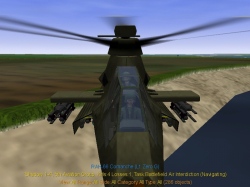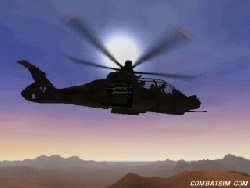Page 3
Flying!
I want to explain my views when I talk about realism, before I go into the FM (flight model) aspects of EECH. I am a commercially rated helo pilot; however, I have never flown any of the helos available in EECH. I can not state with absolute certainty that the performance of the sim will match dead on with the real machine.
Fig. 3. Front View of ComanceWe all know that if that were the case very few people would be able or even willing to learn to fly them on a little computer screen. Let me start by discussing the generally known performance and dynamics of helicopter flight that affects all makes and models. First lets talk about the options that can be turned on and off in the sim:
- Blade stall
This is the Retreating blade stall effect. Turning it on will make the helicopter roll towards the retreating blade as it picks up speed and it will cause a fatal crash if the max speed of the helicopter is exceeded. Having it off will stop both effects from happening. (Direction of the roll is dependent on the helo, While the American helos will roll to the left Russian helos will normally roll to the right.)
- Cross couple
Having this on saves the player from having to use the pedals to counter the main rotor torque. If you do not have pedals or a joystick that twists I would say that you have no choice but to turn this on. When this effect is turned off the body of the helicopter will spin opposite to the direction that the rotor spins. It will require that you use pedal inputs to keep aligned with the direction you want to fly until you have enough airspeed that the wind flow over the body of the helo keeps it facing the right direction. If you have Apache Havoc installed you will have to remember that the main rotor of the havoc spins the opposite direction from the Apache or Comanche so pedal inputs will be backwards. This is just a design difference between counties and will not be a problem when flying the Hokum since it has dual counter rotating main rotors that cancel each other's torque. Wind will push the helo around though so pedal inputs will still be needed for more then changing heading while in a hover. (It also turns out that the Comanche has software that deals with the torque so the pilot workload is decreased.) I have made Razorworks aware of this now and will keep you informed of the solution. The solution for those of you who are not running A-H along with C-H is to just tun CC on as both helos will act correctly in this mode.
- Ground effect
Ground effect causes the helicopters to lose lift as they climb higher than the diameter of the rotor above the ground. You to need add more power if you wish to continue the climb. It also makes you use more power when trying to come to a hover while high above the ground. This can require 100% power to hover OGE (out of ground effect) if you have a heavy weapons load and full fuel. Vortex ring will come into play as a result of this but I will go into that later. Turning off the ground effect will give your helicopter extra lift as if you are IGE at all times.
- Over torque
Over torque isn't so much a flight dynamic as it is a safety feature. When over torque is turned off you can fly the helo in transient power for an unlimited amount of time. Realistically you will overheat and destroy your engines if you continue to use more then 100% of the helos rated torque. The place that this will come into play in a big way is when your ride is damaged and an engine is lost. With only one engine functioning, these helos become very hard to fly using only 100% torque. I honestly can't fault people if they want to turn this option off as is plays more into gameplay then it does realism. I have no idea what the real life numbers for the Comanche or Hokum are but in the Apache it is acceptable to use transient power for single engine, emergency flight. This feature is used to simulate other types of damage you can do to a turbine when flying. It makes for some of the most intense flight time when trying to use transient power for short periods when needed then letting the engine cool before using it again.
- Vortex ring
This is one aspect that will be new to old A-H fans. I have seen messages pop up on the message boards about this already. When you turn this option on you will have some new things to think about while high in the air and slowing below translational lift. You need to have a few things just right (or wrong more specifically) in order to get into vortex ring state. You need to have slow airspeed, high rate of descent and you need to have power on (some collective pulled). Basically what is happening is that you are getting stuck in your own down wash and can no longer generate any lift. The more power you pull the worse your problems will become and the faster you will fall. The only way out of vortex ring state is to get airspeed, to do this you will have to lower your collective and put the nose down. After you have 15+ knots of airspeed back you are free to raise the collective and fly out of it. This should not be an issue if you stay low to the ground where you belong since you need to fall fairly fast to get into it.
- Wind
This has more effect then it did in A-H. Not only will your helo be pushed around by the wind while trying to hover but it will also make your helo crab while in forward flight. If you notice your helos nose isn't pointing the direction you are flying, this is not a bug; it is a design feature. When the weather gets bad you will find that the wind can get very bad in some theaters, it makes flying and fighting without the auto hover features very hard. It also makes you very glad that these are very advanced helos that have these features.
- Translational lift
Effective translational lift (ETL) is something that happens to helicopters as they hit 15-20 knots of airspeed. The rotors hit what we call clean air. This is air that has not been disturbed by the rotor yet. It gives you up to 25% more lift when moving and is something that heavily loaded helos rely upon to keep them in the air. Loosing translational lift while out of ground effect can cause your helicopter to sink getting you into vortex ring state. This feature along with the vortex ring state is going to be tough for some guys to get used to. The thing to remember is to add power and pedal (if cross coupling is off and you are not flying the Hokum) as you slow down below 20 knots. You will get used to doing it and it will become second nature to add some extra power as you come to a hover. If this is turned off you will get the extra lift at all times as you did with the ground effect.
Fig. 4. Commanche Cockpit
© 1997 - 2000 COMBATSIM.COM, Inc. All Rights Reserved.




